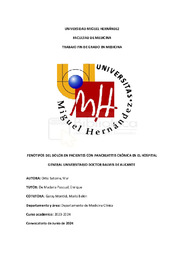Please use this identifier to cite or link to this item:
https://hdl.handle.net/11000/35560Fenotipos del dolor en pacientes con pancreatitis crónica en el Hospital General Universitario Doctor Balmis de Alicante
| Title: Fenotipos del dolor en pacientes con pancreatitis crónica en el Hospital General Universitario Doctor Balmis de Alicante |
| Authors: Ortiz Satorre, Mar |
| Tutor: De Madaria Pascual, Enrique Garay Montiel, María Belén |
| Editor: Universidad Miguel Hernández |
| Department: Departamentos de la UMH::Medicina Clínica |
| Issue Date: 2024-05-10 |
| URI: https://hdl.handle.net/11000/35560 |
| Abstract: La pancreatitis crónica (PC) es una enfermedad con baja prevalencia actual en España, pero con un impacto muy importante en la calidad de vida de los pacientes que la padecen. Se trata de una enfermedad causada, en la mayor parte de los casos, por el consumo de tóxicos, especialmente el alcohol, y normalmente se presenta con mayor frecuencia en hombres. En cuanto a la clínica, el principal síntoma que padecen los pacientes con PC es el dolor abdominal crónico. Este dolor suele estar presente en, aproximadamente, la mitad de los pacientes, siendo el principal condicionante de su calidad de vida. Se trata de un dolor localizado normalmente, a nivel de epigastrio, que puede irradiarse en cinturón. Cabe destacar que no todos los pacientes con PC presentan el mismo fenotipo de dolor. Existen pacientes con dolor crónico continuo, con dolor continuo y periodos de menor dolor, con dolor continuo con exacerbaciones de mayor dolor o con dolor intermitente. En la actualidad, no existe un protocolo de tratamiento estandarizado en estos pacientes. Se utilizan terapias tanto farmacológicas como invasivas, que suelen ser insuficientes. Con el objetivo de mejorar el tratamiento de esta patología, e intentando dirigirlo con mayor especificidad, se están realizado numerosos estudios a nivel internacional que tratan de identificar el fenotipo de dolor de cada paciente, siendo el principal factor predictivo su procesamiento predominantemente periférico o central. Por ello, se ha realizado un estudio transversal retrospectivo, en el que se han incluido 76 pacientes con diagnóstico de pancreatitis crónica en seguimiento en el Hospital General Universitario Dr. Balmis de Alicante (HGUA). Se han incluido los pacientes con diferentes tipos de dolor, así como los pacientes asintomáticos, que han sido valorados en consultas externas de medicina digestiva del HGUA. Se ha visto que, en el HGUA, la mayoría de los pacientes con PC son hombres, con una mediana de edad de 62 años, consumidores de tóxicos, y asintomáticos. Cabe destacar que, entre los pacientes con dolor, siendo aproximadamente un 50%, la mayoría de ellos presenta dolor de tipo intermitente. En cuanto a los tratamientos, se ha observado que menos de un tercio de los pacientes en seguimiento han requerido ingreso hospitalario para control del dolor o cambio en el tratamiento farmacológico en el último año. De esta forma, podemos decir que, la caracterización de los pacientes con PC de nuestro medio permite asentar la base para la realización de futuros estudios que podrían revelar la terapéutica necesaria para el tratamiento del dolor en estos pacientes, que sigue siendo el principal síntoma que padecen. Chronic pancreatitis (CP) is a disease with currently low prevalence in Spain, but with a very important impact on the quality of life of patients who suffer from it. It is a disease caused, in most cases, by the consumption of toxic substances, especially alcohol, and normally occurs in men. Regarding the clinical sympthoms, the main symptom suffered by patients with CP is chronic abdominal pain. This pain occurs in approximately half of the patients, being the main determinant of their quality of life. It is normally a epigastrical located pain, which can radiate like a belt. It should be noted that not all patients with CP have the same pain phenotype. There are patients with continuous chronic pain, with continuous pain and periods of less pain, with continuous pain with exacerbations of greater pain or with intermittent pain. Currently, there is no standardized treatment protocol in these patients. Both pharmacological and invasive therapies are used, which are usually insufficient. With the aim of improving the treatment of this pathology, and trying to focus it with greater specificity, numerous studies are being carried out, and they are trying to identify the pain phenotype of each patient, with the main predictive factor being its predominantly peripheral or central processing. For this reason, a retrospective cross-sectional study has been carried out, which has included 76 patients with a diagnosis of chronic pancreatitis under follow-up at the Dr. Balmis General University Hospital of Alicante (HGUA). Patients with different types of pain have been included, as well as asymptomatic patients, who have been evaluated in the digestive medicine consultation of the HGUA. It has been seen that, in the HGUA, the majority of patients with CP are men, with an average age of 62 years, toxic users, and asymptomatic. It should be noted that, among patients with pain, approximately 50%, the majority of them, have intermittent pain. Regarding treatments, it has been seen that less than a third of the patients under follow-up have required hospital admission for pain control or a change in pharmacological treatment in the last year. In this way, we can say that the characterization of patients with CP in our environment allows us to lay the foundation for carrying out future studies that could reveal the necessary therapy for the treatment of pain in these patients, which continues to be the main symptom that they suffer. |
| Keywords/Subjects: Pancreatitis crónica Dolor crónico Fenotipos de dolor Tratamiento del dolor P-QST Sensibilización central Sensibilización periférica |
| Knowledge area: CDU: Ciencias aplicadas: Medicina |
| Type of document: info:eu-repo/semantics/bachelorThesis |
| Access rights: info:eu-repo/semantics/openAccess |
| Appears in Collections: TFG- Medicina |
.png)

